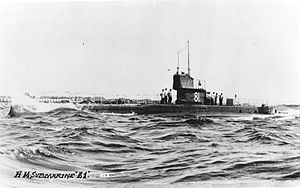British E-class submarine

|
|
| Class overview | |
|---|---|
| Builders: | |
| Operators: | |
| Preceded by: | British D class submarine |
| Succeeded by: | British L class submarine |
| Completed: | 58 |
| General characteristics | |
| Displacement: |
|
| Length: |
|
| Beam: | All Groups: 15.05 ft (4.59 m) |
| Propulsion: |
|
| Speed: |
|
| Range: |
|
| Complement: | All groups: 30 |
| Armament: |
|
The British E class submarines started out as improved versions of the British D class submarine. The E class served with the Royal Navy throughout World War I as the backbone of the submarine fleet. The last surviving E class submarines were withdrawn from service by 1922.
All of the first group and some of the second group of the class were completed before the outbreak of World War I. The group 1 boats cost £101,900 per hull. As submarine technology improved, the E class went through several design modifications. The group 2 boats cost £105,700 per hull. The Group 3 boats, the last group, incorporated all improvements.
The class primarily served in the North Sea and the Baltic, while some served with Russian ships in Russian coastal waters before being their crews scuttled them to avoid having them fall into the hands of the communists, who were gradually taking control of Russia. Additionally, some of the submarines operated against the Turks.
The British L class submarine eventually replaced the E class.
...
Wikipedia
